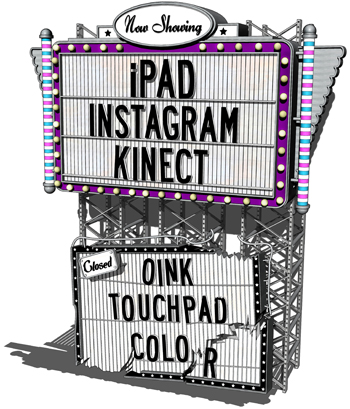Tech is becoming a hits-driven business. This isn't a good thing.
 illustration by stephan walter
illustration by stephan walter
No one waited in line to buy the first iPod. It took a year and a half for Apple's shiny, pricey music player to hit its millionth sale, and nothing about its trajectory (2002 sales, for example, were a Zune-like 40,000 a month) suggested that success lay ahead. Plot the device's early numbers alongside the blockbuster years to come--in 2008, Apple sold 56 million iPods--and you'd need a retina display to see the few pixels representing 2001, 2002, and 2003.
As digital culture has become mainstream culture--pushed along by, yes, Apple and its now masterfully calibrated launch events--the iPod's slow start would make it a dud today, the TouchPad of music players (remember HP's ill-fated tablet? Me neither). Tech has now become about hits, not unlike Hollywood movies. And the numbers for what defines a smash are only growing: In 2010, Microsoft's Kinect motion-gaming add-on sold 8 million units in 60 days, earning it a Guinness world record. A year later, Apple sold 33 million iPhone 4S's in its first 78 days. The Instagram photo-sharing app attracted 7 million users in its first nine months; this spring, the Draw Something app wooed 35 million people in its first six weeks, prompting Zynga to buy it for a reported $180 million. On the flip side, slow starters are being kicked to the curb. The recommendation app Oink, backed by a Silicon Valley Who's Who, didn't pop and shut down after a few months, the John Carter of the App Store.
"There's a subsection of people in the Valley who think the only way to be successful is to create a viral overnight hit," says Path's Dave MOrin.These megahits present a danger for the tech business. The iPod's early years suggest that the industry will lose something in the rush to kill off products that don't catch fire immediately. "There's a subsection of people in the Valley who think the only way to be successful is to create a viral overnight hit," says Dave Morin, CEO of the social-networking app Path, which attracted nearly a million registered users in its first year. That's a more modest start than, say, Pinterest, but Morin points out that Facebook, Flickr, LinkedIn, and Twitter all took years to gain millions of users.
He's right: New technology isn't like a movie, a finished product that you either like or you don't. High-quality tech products take time--after they're released. It's relatively easy to get a lot of people to check out your new thing: see MySpace, Chatroulette, or any number of Zynga games. But it takes more determined work, more trial and error, to keep them using your product. Look at all of Facebook's redesigns, missteps, and reorganizations on the path to winning big.
Lasting technologies also need an ecosystem of complementary products. In 2005, when Sonos launched its amazing wireless home speaker system, people didn't have access to apps-enabled smartphones with which to control Sonos's gear. The company had to create its own expensive controller. There were also few music services like Spotify for users. Most consequentially, "listening to music at home had largely gone away," says CEO John MacFarlane. "We had to get people to rediscover it." Sonos sold 20,000 units its first year, but as the ecosystem took root, it reached its one-millionth home in 2011.
Finally, users need to be ready for the innovations on offer. Morin noticed that of the million people who registered for Path's app in its first year, only a tiny percentage were using it every day. Facebook sufficed. Last fall, Path launched a more streamlined app that improved what appealed to its daily loyal users. It reminded many people of what Facebook was before it became so big, and Path's usage jumped by a factor of 30. Morin thinks of the second Path as "an attempt to create a more pure version of the original vision," The Godfather: Part II of apps. If the tech industry lets insta-hits warp its iterative genius, too many promising but slow-starting products will sleep with the fishes.
A version of this article appears in the June 2012 issue of Fast Company.
